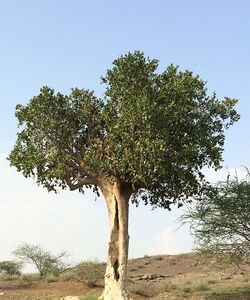Biology:Dobera glabra
| Dobera glabra | |
|---|---|

| |
| Scientific classification Error creating thumbnail: Unable to save thumbnail to destination
| |
| Kingdom: | Plantae |
| Clade: | Tracheophytes |
| Clade: | Angiosperms |
| Clade: | Eudicots |
| Clade: | Rosids |
| Order: | Brassicales |
| Family: | Salvadoraceae |
| Genus: | Dobera |
| Species: | D. glabra
|
| Binomial name | |
| Dobera glabra (Forssk.) Juss. ex Poir.
| |
Dobera glabra is an evergreen shrub or tree native to the Somali peninsula, Northeastern Kenya and Ethiopia as well as South Tihamah. In Somali speaking regions, it is widely known as Garas. In Ethiopia, you will find it in Nechisar National Park and along the Sagan River in the Konso special woreda. It is also sparsely distributed in Afar Region where the tree is much known for its fruits. It is known to grow up to 10 metres (0.0062 mi) in height.
It is well known to the local Konso people (who call it karsata) for growing new shoots, flowers, and seeds during dry weather. They use it as an indicator of potential famine and drought conditions. D. glabra produces edible fruits and the seed is considered a typical famine food. However, the fruits must be cooked for a long time (i.e. up to 24 hours), they have a bad smell, and excessive consumption causes stomach aches and other intestinal problems.[1]
General description
It is an much branched evergreen shrub or tree up to 8m. The bark is green to dark grey and patchy. Leaves are opposite, yellow to grey-green, thick, smooth, veins hardly seen, up to 7 cm long, tip usually notched. Flowers are small and white in colour. Fruits are ovoid to 2 cm, with 1 - 2 flat seeds. Paradoxically it produces better and more seeds in dry spell (under moisture stress conditions) than in normal times.[2]
References
- ↑ Yves Guinand and Dechassa Lemessa, "Wild-Food Plants in Southern Ethiopia: Reflections on the role of 'famine-foods' at a time of drought" UN-OCHA Report, March 2000 (accessed 15 January 2009)
- ↑ "category1". https://www.africa.upenn.edu/faminefood/category1/cat1_Dobera_glabra_ok.htm.
Wikidata ☰ Q4120543 entry
 |

